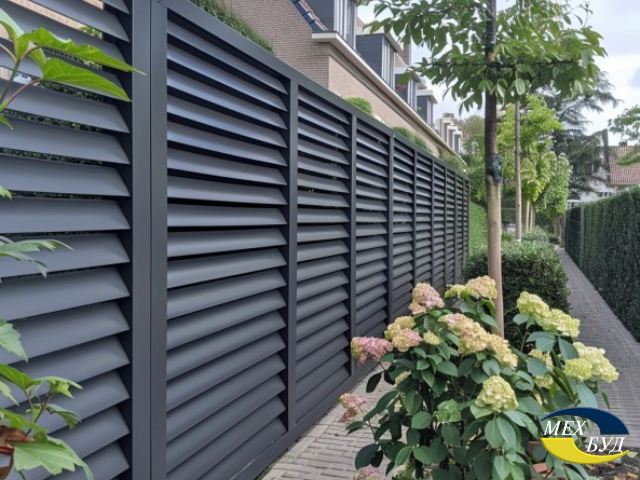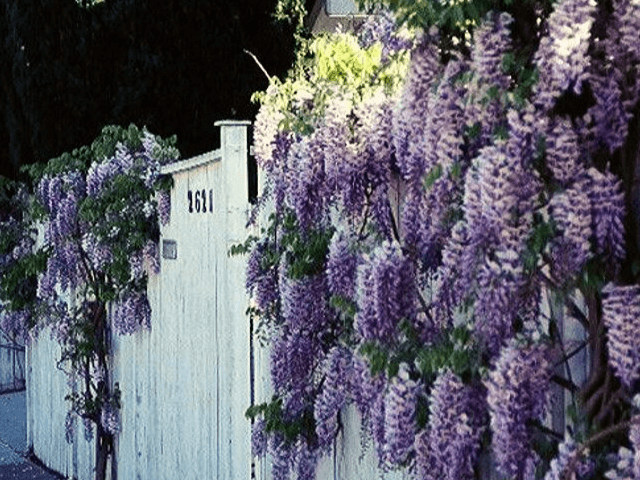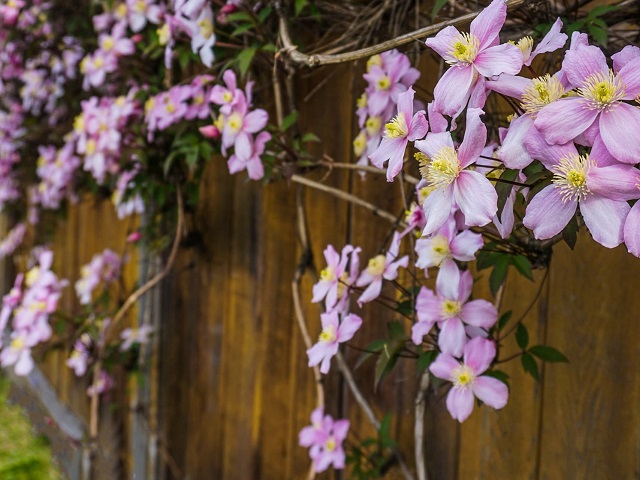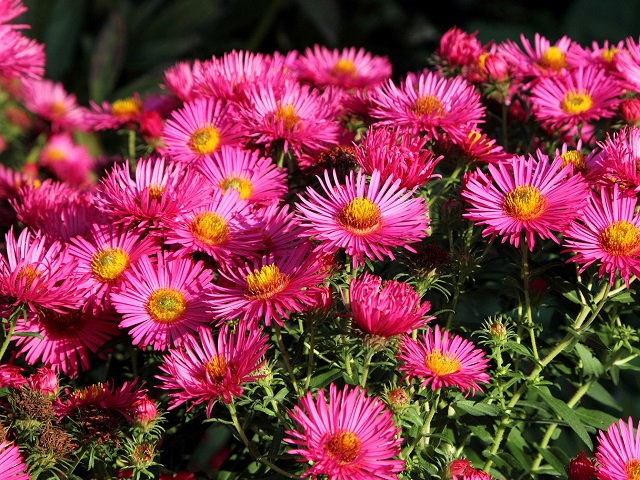What to Plant Under the Fence
Plants near the fence shape the overall impression of the site and, of course, the owner themselves. Undoubtedly, they should be there, but which ones are best to use for planting near solid fences, and which for ventilated ones? That’s what our article is all about.
It is important to note that it is best to plant plants in the fall. There are very few plants that are planted in the spring. These are only the flowers that finish flowering in the middle of summer. By planting seedlings in the fall, you can guarantee that they will establish well in the soil before the frost sets in.
After planting shrubs and trees in the fall, mulch is placed around the plants. It will prevent the plants from freezing during the winter.
Object Minimum Distance (m)
| Up to tree trunks | Up to shrubs | |
| Exterior walls of the building | 5 | 1,5 |
| Outer edge of the ditch, trench | 2 | 1 |
| Base of retaining walls | 3 | 1 |
| Edges of garden paths | 0,7 | 0,5 |
| Fences (height up to 2m) | 1,5 - 2 | 0,75 - 1 |
| Fences (height over 2m) | 4 | 1 |
| Street roadway | 1,5 -2 | 1 |
| Underground networks and utilities | ||
| Gas pipeline, sewerage | 1,5 | |
| Power cable and communication cable | 2 | 0,7 |
| Heat pipe (from canal walls) | 2 | 1 |
| Water supply, drainage | 2 | - |
When choosing plants for planting under the fence, it is important to consider several key factors:
- Sunlight: Determine how well the selected area is illuminated throughout the day.
- Soil type: Make sure the soil is suitable for the chosen plants or can be appropriately prepared.
- Moisture: Some plants prefer dry conditions, while others require a more humid environment.
- Height and shape of plants: Plan how the plants will look in a few years, considering their potential height and shape.

Thuja
Thuja is an evergreen coniferous plant belonging to the Cypress family. They are evergreen and delight their owners with their rich color all year round.
The unpretentious and evergreen thuja is a worthy decoration for any plot, and as a fence, it is universal. With the help of thuja, you can create a “living hedge” up to 20 meters high. It can be made into a simple fence, as well as shaped into various forms such as arches, spheres, sculptures, etc.
Thuja is perfectly suited for trimming and maintains its shape for a long time. Additionally, thuja fills the air around it with phytoncides, which have a positive effect on human health.
It also protects against gases, dirt, dust, and wind.

LAVENDER
Lavender is an attractive and aromatic plant widely used in landscape design. Narrow-leaved lavender is most often grown. This versatile flower looks organic in various compositions. The shrub of this species can reach a height of 1 meter, with flowering period in June-July.
Lavender goes well with any plants that do not shade it from the sun. But it looks most spectacular next to white, dark purple, blue, yellow, orange, and pink flowers (such as poppies, sage, sedum). This color palette leaves no one indifferent.
Certainly, the plant will take root even in the shade, but it will not bloom abundantly in such conditions. Lavender also grows poorly in wet areas, so it should not be planted in lowlands or places with high groundwater levels.
When growing this plant, it should be remembered that it is very sensitive to soil acidity (the optimal pH level is 6.5-7.5), as well as its structure.

CONIFEROUS PLANTS
Even in severe frosts, they retain their attractiveness and give the site a well-groomed look. Professionals appreciate coniferous trees for their unpretentiousness, strikingly laconic crown, and durability. They are used for elegant accentuation of garden areas, as a finishing touch in landscape design compositions. Designers create amazingly beautiful combinations of trees with different qualities and colors of needles. These “bouquets” are surprisingly hardy, delighting not only with their external splendor but also with their unique ability to perfume and purify the air. Coniferous trees are specially cultivated for landscape design in nurseries: fir, pine, juniper, fir, cedar. An extraordinary representative of conifers is larch. In winter, it sheds its needles.

BARBERRY
It is ideal for decorating any ventilated fence. Barberry will be a real highlight when decorating your site. Low-maintenance, all it needs is regular watering during the active fruiting period.
The plant feels equally comfortable in both shade and sunlight. It is a medium-sized bush with long branches, so it should be planted at least 2 meters away from the fence. Barberry does not like cold northern winds, so this should also be taken into account when planting. It is best to choose the southern or western part of the fence for it.

LILAC
Of course, it occupies honorable places in the plots. However, it is difficult to call lilac unpretentious – it requires good lighting and a low level of groundwater. The most frost-resistant variety is Amur lilac. Without proper care, the bush will not look too presentable. So lilac should be planted only if there is time for care. To form a living fence from a bush, it needs to be constantly trimmed and young shoots directed in the right directions.
SMOKE TREE
One of the oldest decorative shrubs used in landscape design for decorating territories and creating living fences. This tree belongs to the category of evergreen plants, so it pleases its owner with impeccable appearance even in winter.
Varieties of smoke tree:
Evergreen smoke tree — in natural conditions, it is common in the countries of the Mediterranean and the Caucasus. It feels good both in partial shade and in the sun. If not pruned, it can grow up to 3 meters in height.
Small-leaved smoke tree – unlike its previous relative, this dwarf shrub is less sensitive to winter cold. It is a descendant of the families of South Asia and can withstand frost down to 30 degrees without shelter. Valued for its compact form and decorative crown.
Balearic smoke tree — the largest species of the family, its leaves reach up to 5 cm in length. The Balearic Islands of Spain are considered its habitat. It is common in the mountains in the south of Spain, Portugal, and the Crimean coast.
It is best to plant on a cloudy day. Small pits are dug in the prepared soil, slightly wider and deeper than the root ball. You can orient yourself by the size of the container in which the plant was located. In the case of planting several trees to form a living hedge or border, a wide and deep trench is dug. It is necessary to pour a layer of compost 10-15 cm high on the bottom of the trench and mix it with the soil using a fork. When preparing seedlings, make sure that the roots are spread out and do not stick out to the sides. After the bush is covered with soil, a depression is formed around the trunk to collect water. The plant should be watered carefully.

ROSES
Transform your fence from being rigidly separating your plot from the rest of the world by planting roses along it. Combined with the white fence, it creates the impression that you are in an old European estate. Pink and white roses evoke Victorian chic, while red and burgundy ones evoke associations with Mediterranean landscapes.
Roses add charm to any corner of the garden, yet they have a flexible character allowing them to be used in different landscape styles. French formal gardens or sentimental shabby chic, Victorian or Mediterranean, exemplary variant or a landscape mimicking natural nature.
If you have no specific stylistic preferences, you can choose the rose varieties and planting method that you like the most. In the case when the garden style is already established (or you want to see it in a completely certain style in a few years), it makes sense to look for roses that are suitable specifically for such a landscape style.
It is better to plant wild rose or rosehip along the fence not from the street side, but from the house side. This is because you can collect rosehip berries from the shrub, which can be dried and used in household. For example, rosehip is very rich in vitamin C, it can be added to compote along with dried fruits. It is better to plant it from the house side, as near the road it can absorb harmful gases from cars. However, if the dacha is located in a place far from the highway or road, it is quite possible to plant rosehip from the street side. And from the side of the neighbors in the flower bed, it will also be a beautiful fence. Moreover, rosehip blooms beautifully, so it will also delight with various pastel shades of roses.

WISTERIA
Chinese wisteria is a favorite of landscape designers. Lilac vine wisteria is grown in tubs, in open areas, and even in pots. Flowering wisteria is good for decorating the landscape, balconies, terraces, loggias, gazebos, and facades of houses.
In closed ground, seeds are sown in winter, approximately at the end of December – beginning of January. In open ground, seeds are sown in early spring, as soon as the soil warms up well. The optimal period for sowing in open ground is the second half of March – early April.
Bright large plant can be used as a screen, covering hidden areas of the garden from prying eyes, decorate utility buildings. But wisteria is able to destroy a fragile fence or an old barn with the weight of its branches.
A light-loving vine adorned with white, lilac, or pink clusters of small flowers is able to transform even the most inconspicuous fence into a spectacular plot boundary.

DEREN
It is one of the most popular shrubs when decorating a fence. Deren grows well on any territory, including in Siberia. In summer, it is adorned with flowers, and in autumn – with white fruits.
It has an incredibly interesting color with a silvery bloom. And if you plant low-growing conifers nearby, the composition will be very interesting.
Derain is easy to prune and shape. It forms well, quickly forming reliable protection against dust.
If you plant a seedling in the spring, by the beginning of autumn it will be a meter high. Many are attracted by such a newcomer, but it should be borne in mind that the derain needs decent living space. Therefore, if you want to see more different shrubs along the fence, you need to look closely at other species.

JASMINE
Blooming and fragrant shrub, its white flowers attract attention and adorn the facade. It is recommended to plant it on the outer side of the street.
Jasmine grows well in nutrient-rich soil but can also thrive in poor soil. The plant will feel very comfortable in a sunny location, but it is undesirable to plant it where groundwater is too close to the surface.
Jasmine is resistant to pests and diseases. It rarely suffers from powdery mildew or aphids.
It is important to note that jasmine requires care. It needs regular pruning; once a year, it should be cleaned of aging and dried shoots. Thinning out the stems and removing faded inflorescences will promote better growth and even more abundant flowering.
And, as needed, trim it to maintain the desired shape and beauty.
HYDRANGEA
Hydrangea is a shrub with beautiful large flowers of white, pink, blue, or purple color. Hydrangeas require an adequate amount of moisture and do not tolerate drought, so it is important to take care of them, especially in hot summer months.
They grow well in semi-shaded and partially shaded areas, so planting hydrangea under a fence that shields from direct sunlight would be an excellent solution.
CLEMATIS
Clematis is a vine that can grow up to 3-4 meters in height. It has bright flowers of various shades, from white to red.
Clematis also prefers partial shade, so planting them under a fence would be a good idea. Clematis leaves may wilt if exposed to direct sunlight for extended periods, so it is better to plant the vine on the north side of the fence or in a location where it will be partially shaded.

ASTERS
Asters are beautiful and bright flowers that can be an excellent choice for planting under a fence. They are available in various shades, from white to red and violet, and can be both annual and perennial plants.
One of the most popular perennial asters is the New England Aster, which has large, bright flowers and can grow up to 1.5 meters in height. It can be planted next to the fence to create an attractive floral barrier. Asters can also be used as a living hedge by planting them in a row along the fence.
Annual asters can be enjoyed every year by replanting them in a new location. It is advisable to choose varieties that are easy to grow and do not require much care, such as Chinese Asters. These flowers have small blooms and are available in various colors.
However, when planting asters under a fence, it should be noted that they require a good amount of sunlight and a good drainage system to avoid overwatering. Overall, asters can be a wonderful choice for creating a beautiful and colorful plant fence.

Do you need to maintain a certain distance between plants and the fence?
Yes, it is important to leave enough space between plants and the fence to ensure adequate air circulation and prevent damage to the fence from roots or branches. The recommended distance depends on the type of plants, but a general rule is to leave a minimum of 30-50 cm from the fence.
How often should plants under the fence be watered?
The frequency of watering depends on the type of plants, weather conditions, and soil type. In summer, during hot days, watering may be necessary every 2-3 days. In cooler weather or for plants with deep roots, watering may be less frequent. It is important to provide sufficient watering but avoid waterlogging.
Can plants be planted under the fence if there is little sunlight?
Yes, there are plants that thrive in partial shade or even deep shade. Such plants include hostas, ferns, and some varieties of clematis. Choose shade-tolerant plants for shaded areas under the fence.
How to protect plants under the fence from pests and diseases?
Regularly inspecting plants for signs of pests or diseases and timely application of protective measures can help avoid problems. Use natural or recommended remedies for pest control, and provide proper care to promote healthy plant growth.
What plants are best suited for creating privacy under the fence?
For creating privacy, evergreen shrubs and medium-sized trees are ideal, such as western red cedar, noble laurel, or tall varieties of cotoneaster. They provide dense foliage year-round and can be pruned to achieve the desired height and shape.
Does the choice of plants under the fence affect the overall landscape design?
Yes, the choice of plants under the fence can significantly impact the overall appearance of your garden or yard. Plants can help integrate the fence into the landscape design, create color accents, or visually divide the space into zones. Choose plants that harmonize with other elements of your garden in color, texture, and style.
